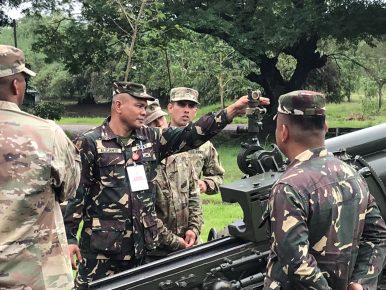Engagement is another sign of a relationship on the uptick following a rocky start under the new Philippine president.

Image Credit: US Embassy Manila
This month, the United States and the Philippines carried out another one of their series of military exercises and engagements. The engagement, which occurred under the SALAKNIB banner, is testament to a bilateral defense relationship that is on the uptick despite some lingering challenges under new Philippine President Rodrigo Duterte and U.S. President Donald Trump (See: “Trump’s Indo-Pacific Strategy Challenge”).
As I have noted before in these pages, though the U.S.-Philippine defense relationship had a bit of a rocky start once Duterte took office, developments particularly in the latter part of 2017 suggest that, as was likely to be the case, any kind of perceived downgrading on the defense side might not only be slowing, but beginning to reverse in a trend that might continue out to 2018 (See: “How Much Will Duterte Wreck the US-Philippines Military Alliance?”).
Several factors, including new appointed personnel in the bilateral relationship as well as ongoing developments such as the siege by Islamic State militants in the southern Philippine city of Marawi, have helped reinforce the importance of collaboration on this front and paved the way for new areas of cooperation as well (See: “US Terror Aid to Philippines Signals Enduring Defense Ties Under Duterte”). As a U.S. treaty ally, the Philippines will also have a key role to play in Trump’s developing Asia vision as was clear during the Trump-Duterte summit earlier this month. The Philippines likewise played a key role during Barack Obama’s rebalance to the Asia-Pacific (See: “Why the Philippines is Critical to the US Rebalance in Asia“).
That remains true on the exercise dimension of bilateral defense ties too. Following the recent annual meeting in Hawaii of the Mutual Defense Board-Security Engagement Board (MDB-SEB) – the body which deliberates on these interactions – Philippine officials had indicated that the number of exercises and engagements would increase in 2018 from 2017 levels (even though they would still be still lower than that of 2016) (See: “What Will US-Philippines Military Exercises Look Like in 2018?”).
This month, another engagement took place that demonstrated the enduring defense ties between the two countries. From November 16 to 27, U.S. Army and Philippine Army (PA) soldiers conducted SALAKNIB (which means “Protector” in Illocano) in Luzon, the Philippines, which involved subject matter expert exchanges as well as practical exercises. The Philippine Army said that the exercises took place in various military facilities including Camp O’Donnel in Capas, Tarlac; Fort Magsaysay in Palayan City, Nueva Ecija; and Fort Bonifacio, Taguig City.
According to the U.S. Embassy in the Philippines, soldiers shared information such as gunnery procedures, maintenance for the M113 Armored Personnel Carrier, artillery tactics and processes, as well as study and validation of the PA Sustainment Functional Concept Document, the document which establishes a common framework for sustaining future Army operations. Philippine soldiers also fired artillery and M113 Gunnery in a display of their skills.
The Embassy said the engagements in SALAKNIB would serve as a foundation for future training, which will include SALAKNIB Part B in April 2018 and culminate in the BALIKATAN exercises in May 2018, the biggest annual bilateral exercise between the two sides. Despite the initial scaling down of the Balikatan exercises last year, the drills remain significant for several reasons including growing multilateralization, with last year seeing participation from U.S. allies Japan and Australia and eight Southeast Asian nations as observers (See: “How Significant is the 2017 US-Philippines Balikatan Military Exercise?”).
https://thediplomat.com/2017/11/us-philippines-military-exercise-signals-strengthened-defense-ties-in-the-duterte-era/

No comments:
Post a Comment
Note: Only a member of this blog may post a comment.